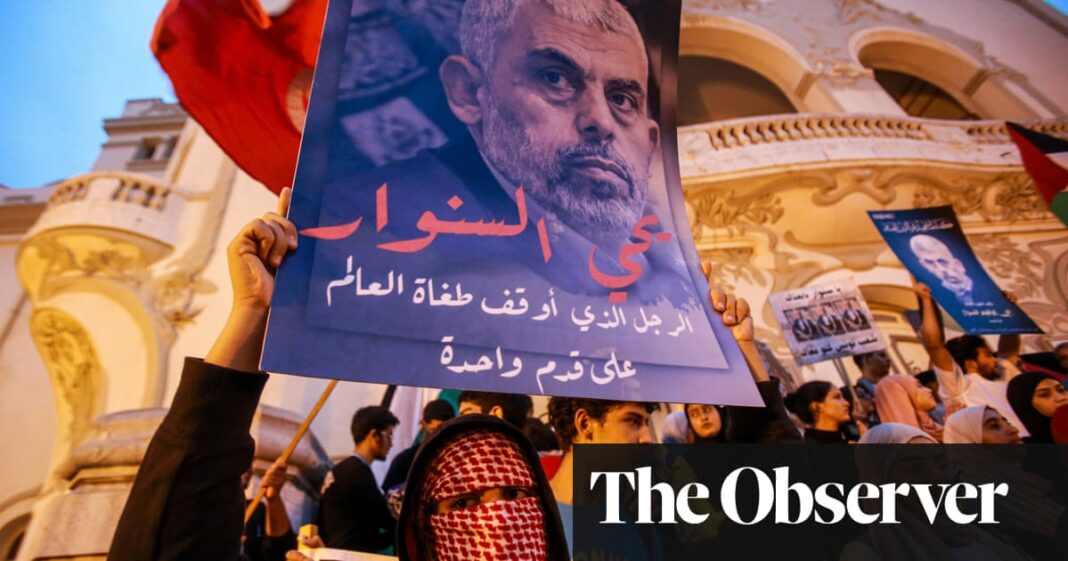A discrepancy in the official Israeli account of Yahya Sinwarâs final moments has emerged since his death which appears likely to add fuel to the martyrâs cult fast developing around the Hamas leader.
The Israeli autopsy carried out on Sinwar concluded that he died from a gunshot wound to his head, at odds with the initial Israel Defense Forces (IDF) version which implied he was killed by a tank shell fired into the wrecked building where he made his last stand.
The IDF released footage of a tank firing at the building in Rafahâs Tel al-Sultan refugee camp, and the military spokesperson, R Adm Daniel Hagari, said: âWe identified him as a terrorist inside a building, fired at the building and then went in to search.â
However, according to Chen Kugel, the director of Israelâs national forensic institute, who carried out the autopsy, the cause of death was a bullet wound to the head. In an interview with the New York Times, Kugel did not speculate on who fired the fatal shot, whether it was during a skirmish with Israeli soldiers before the tank round was fired, or after he was found in the rubble of the building, or by Sinwar himself so as not to be taken alive.
Sinwar had a pistol with him, which some Israeli reports said had previously belonged to an IDF military intelligence officer, Mahmoud Hir a-Din, a Druze from the Galilee region, who was killed during a secret mission in Gaza in 2018.
The intrigue surrounding Sinwarâs death has fuelled a martyrâs cult that spread explosively across social media from the moment the Hamas leader was confirmed dead.
The fact that he was killed in combat fatigues and a combat vest after firing and hurling grenades at Israeli soldiers, even lashing out at an IDF drone with a wooden baton thrown with his one remaining working arm in a final gesture of defiance, sets Sinwar apart from his predecessors who were assassinated while they were on the run.
When the long-serving Hamas leader Sheikh Ahmed Yassin was assassinated by missiles fired by an IDF helicopter gunship in 2004, he was being pushed along in a wheelchair after prayers in a Gaza mosque.
There was little of his body left to photograph, but imagined pictures of the fatal missile strike became part of the iconography which almost instantly appeared on walls across the occupied territories, along with images of the white-bearded leader ascending to heaven. Pictures of Yassin are still common in Gaza and the West Bank, often showing him in the company of more recent martyrs.
Sinwar left a war-ravaged fighterâs corpse behind, providing a final image comparable to those of Che Guevara, the Argentinian doctor who fought in Cubaâs revolution but who ultimately died at the hands of the Bolivian military in 1967, and became an icon for his cause. After Guevara was shot, his body was laid out on a table to be photographed, his open eyes staring vacantly at the camera.
Sinwarâs successors in the Hamas leadership celebrated the fact that he died in combat, in the words of his deputy, Khalil al-Hayya: âFacing and not retreating, engaging in the frontlines and moving between combat positions.â
An excerpt from a notable poem by the Palestiniansâ most celebrated poet, Mahmoud Darwish, is circulating on the internet along with the claim that it foretold Sinwarâs end.
The lines from Praise for the High Shadow say: âBesiege your siege ⦠there is no escape. Your arm has fallen, so pick it up and strike your enemy ⦠There is no escape and I fell near you, so pick me up and strike your enemy with me ⦠You are now free, free and free.â
Darwish wrote the poem at another low point for the Palestinian cause, in a boat taking him and other activists and militants from Beirut to Tunisia after Israelâs devastating war in Lebanon in 1982 aimed at destroying the Palestinian Liberation Organisation.
Darwishâs poetry recalls the horror of the shelling of Beirut and the massacres of Palestinians and Lebanese Shia Muslims at the Sabra and Shatila refugee camps in Lebanon at that time. The themes of mass death in the face of international indifference and inaction, combined with the longing for someone to strike back, resonate with Palestinians today after Gazaâs destruction.
Sinwarâs warriorâs death seems certain to guarantee him the top place in the Palestinian pantheon, obscuring the fact that, before 7 October last year, as a brutal enforcer of Hamas loyalty, he killed far more Palestinians than Israelis, killing suspected informants in the most gruesome manner. Last yearâs murderous attack on Israeli civilians in southern Israel left Gaza open to ferocious Israeli reprisals and Palestinian civilians exposed, starving and vulnerable while Sinwarâs fighters hunkered in tunnels well stocked long before with food, water and medication.
To further help shape his desired narrative, the Hamas leader left behind a text, in the form of a 2004 autobiographical novel, The Thorn and the Carnation, written in Israeli prison and smuggled out in sections.
Sinwarâs alter ego in the book, Ibrahim, is a zealot committed to the cause who expects Palestinians to be âready to sacrifice everything for their pride, dignity, and beliefsâ. Why negotiate with Israel, Ibrahim asks, when Hamas could âimpose other rules of the gameâ?
That is what Sinwar thought he was doing with the 7 October attack, and what he clearly hoped would be his legacy. The myth surrounding him, which he cultivated assiduously while still alive, seems certain to live on through thousands of posters and street murals.
His legacy has also been to âchange the rules of the gameâ but it is far from clear yet whether the change favours the Palestinians.


